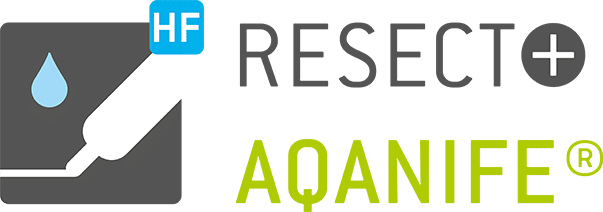
Monopolar HF instrument for endoscopic submucosal dissection (ESD) with flushing and reinjection capability.
+49 (0) 7071 96528 160
service@ovesco.com

+49 (0) 7071 96528 160
service@ovesco.com
Instrument for flexible endoscopy for dissection of tissue e.g. in endoscopic submucosal dissection (ESD) and for haemostasis during this prodecure.
The AqaNife® is a monopolar electrosurgical instrument for dissection using flexible endoscopes with a working channel diameter of minimum 2.8 mm. It is a fixed dissection knife and provides the following advantages:
| Slider (A) for feeding forward (1) and retracting (2) the dissection electrode | |
| HF connector (3 mm) (B) | |
| Flexible shaft with irrigation channel (C) | Shaft length: 220 cm |
| Straight HF knife (needle-shaped electrode) for dissection and coagulation of tissue (D) | Needle lengths: 1.5 mm | 2.5 mm |
| Irrigation connection (E) | |
| Appropriate working channel diameter | From 2.8 mm |
| Packaging unit | 1 piece |
| Article number | 200.53.01 ; 200.53.03 |
Endoscopic Submucosal Dissection consists of several steps. The first step is usually the placement of coagulation marks around the lesion with a safety margin. This facilitates identification of the resection margin during the procedure. The AqaNife® can be used for this step.
The next step is submucosal liquid injection to lift the mucosa from the muscular layer. Then follows the incision of the mucosa and the subsequent RF-dissection of the submucosal space with the tip of the AqaNife®.
Lost fluid, occurring during dissection over time, can be replaced without instrument change by gently inserting the tip of the AqaNife® into the submucosa and fluid injection.
Besides the AqaNife® also the Coag Dissector can be used for tissue dissection. As in surgical dissection, the specially shaped jaws of the instrument can be applied to gently spread the tissue and bluntly dissect the submucosal space. Also bleeding can be stopped, applying the Coag Dissector as a coagulation grasper.
